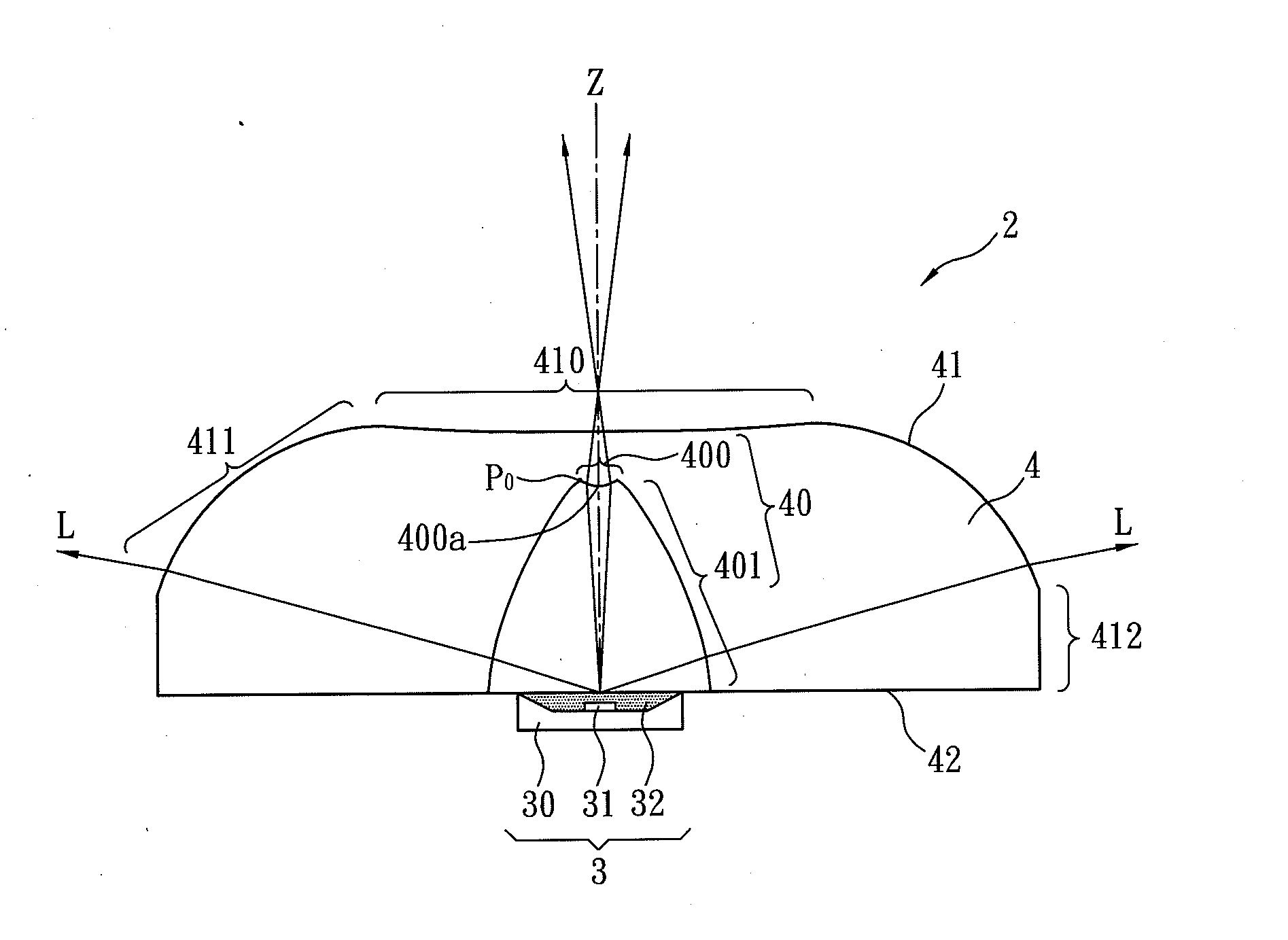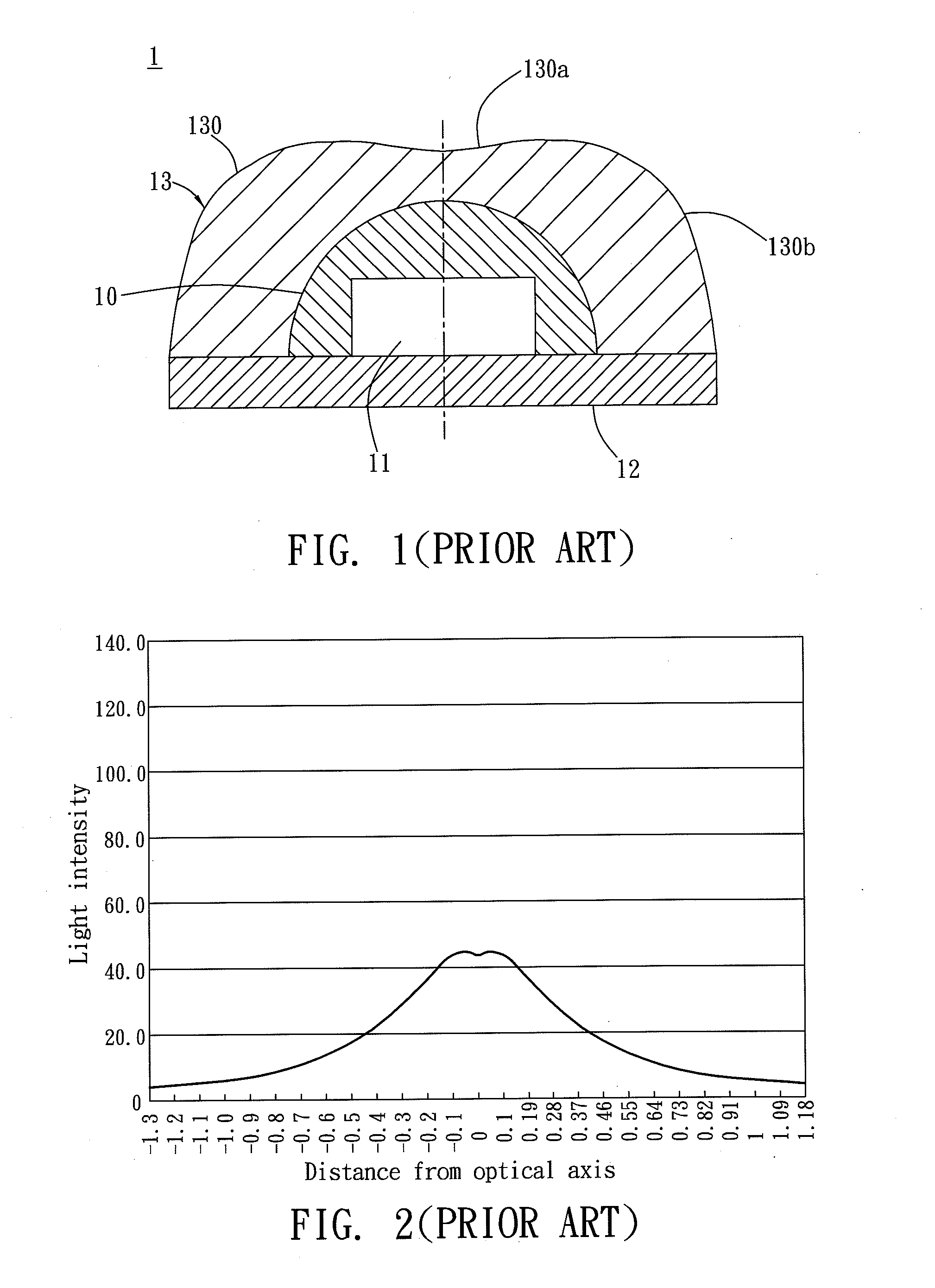LED lens and light emitting device using the same
a technology of light-emitting devices and lenses, which is applied in the direction of semiconductor devices, lighting and heating apparatus, instruments, etc., can solve the problems of difficult to achieve high light-scattering ability and uniform light distribution of light source devices simultaneously, and light patterns with higher intensities in the paraxial region, so as to improve illumination uniformity and effective divergence angle
- Summary
- Abstract
- Description
- Claims
- Application Information
AI Technical Summary
Benefits of technology
Problems solved by technology
Method used
Image
Examples
first example
[0071]FIG. 8 is a cross-sectional view illustrating a light emitting device of the first example according to the present disclosure. In the first example, the light emitting surface 41 of the LED lens 4 has a shape according to table (1) listed below that shows coefficients of the aspheric surface formula (7).
TABLE (1)curvature (c)KA2A4A6A8A10A12−6.42E+12−2.23E+062.01E−02−1.44E−032.08E−05−4.89E−079.44E−09−9.54E−11
[0072]In Table (2) listed below, it shows the refractive index (Nd) of the LED lens 4, the data referred to FIG. 4, and the space distance (d) between the first plane and the second plane is located in the first example.
TABLE (2)Lt (mm)Re (mm)Rer (mm)tanθerRi (mm)Rir (mm)OI0 (mm)θT (°)4.69415.2005.66012.9263.5000.4682.25071tanθ0Sir (mm)OP0 (mm)Dir (mm)tanθird (mm)NdθM (°)0.0970.3112.4250.1641.430−0.8001.49156
[0073]In the first example, the first optically active area 400 of the light incident surface 40 is a concave surface. For detail description of the concave surface of...
second example
[0076]FIG. 9 is a cross-sectional view illustrating a light emitting device of the second example according to the present disclosure. In the second example, the light emitting surface 41 of the LED lens 4 has a shape according to table (3) listed below that shows coefficients of the aspheric surface formula (7).
TABLE (3)curvature (c)KA2A4A6A8A10A12−6.42E+12−2.23E+062.01E−02−1.44E−032.08E−05−4.89E−079.44E−09−9.54E−11
[0077]In Table (4) listed below, it shows the refractive index (Nd) of the LED lens 4, the data referred to FIG. 4, and the space distance (d) in the second example.
TABLE (4)Lt (mm)Re (mm)Rer (mm)tanθerRi (mm)Rir (mm)OI0 (mm)θT (°)4.72615.5005.36035.3843.6000.6202.74570tanθ0Sir (mm)OP0 (mm)Dir (mm)tanθird (mm)NdθM (°)0.1050.3702.9610.2001.5530.0001.49156
[0078]In the second example, the first optically active area 400 of the light incident surface 40 is a concave surface. For detail description of the concave surface of the light incident surface 40, it drops from the opt...
third example
[0081]FIG. 10 is a cross-sectional view illustrating a light emitting device of the third example according to the present disclosure. In the third example, the light emitting surface 41 of the LED lens 4 has a shape according to table (5) listed below that shows coefficients of the aspheric surface formula (7).
TABLE (5)curvature (c)KA2A4A6A8A10A12−6.42E+12−2.23E+062.01E−02−1.44E−032.08E−05−4.89E−079.44E−09−9.54E−11
[0082]In Table (6) listed below, it shows the refractive index (Nd) of the LED lens 4, the data referred to FIG. 4, and the space distance (d) in the third example.
TABLE (6)Lt (mm)Re (mm)Rer (mm)tanθerRi (mm)Rir (mm)OI0 (mm)θT (°)4.69415.5005.36049.6043.8000.6163.19471tanθ0Sir (mm)OP0 (mm)Dir (mm)tanθird (mm)Ndθm (°)0.0920.3443.3620.1541.9990.2001.49156
[0083]In the third example, the first optically active area 400 of the light incident surface 40 is a concave surface. For detail description of the concave surface of the light incident surface 40, it drops from the optica...
PUM
 Login to View More
Login to View More Abstract
Description
Claims
Application Information
 Login to View More
Login to View More - R&D
- Intellectual Property
- Life Sciences
- Materials
- Tech Scout
- Unparalleled Data Quality
- Higher Quality Content
- 60% Fewer Hallucinations
Browse by: Latest US Patents, China's latest patents, Technical Efficacy Thesaurus, Application Domain, Technology Topic, Popular Technical Reports.
© 2025 PatSnap. All rights reserved.Legal|Privacy policy|Modern Slavery Act Transparency Statement|Sitemap|About US| Contact US: help@patsnap.com



